There are a number of memorials connected to victims of Nazism in the Channel Islands and you can read about each one in depth below. The memorials described here include:
GUNS Blue Plaque in Guernsey
Deportee Memorial in Guernsey
Foreign Workers Memorial in Guernsey
Internees Memorial in Jersey
Guernsey Jewish Memorial
Jersey Jewish Memorial
Lighthouse Memorial Jersey (pictured right)
Blue Plaque for Marie Ozanne in Guernsey
Maurice Gould’s Grave in Jersey
Memorial to Louisa Gould in Jersey
Pavement Quotes in Jersey
Political Prisoner Memorial in Jersey
Resistance Memorial in Guernsey
Occupation Tapestry in Jersey
Westmount Salve Workers Memorial in Jersey
Recommended Texts
Sanders, P. (2004). The Ultimate Sacrifice. Jersey: Jersey Heritage.
Carr, G. (2014). Legacies of Occupation: heritage, memory and archaeology in the Channel Islands. New York: Springe
Cohen, F. (2000). The Jews in the Channel Islands during the German Occupation 1940-1945. Jersey: Jersey Heritage Trust

Blue plaque to GUNS in Guernsey
On 23 April 2017, a Blue Plaque was unveiled to the men and women involved in the Guernsey Underground News Service (GUNS). The plaque was placed on the former offices of the Star newspaper in memory of Charles Machon, GUNS ringleader, and one of the Guernsey Eight. The production of the news service was prompted by the confiscation of radios by the German authorities, who promptly made owning a radio and listening to the BBC news a punishable offence. The families of all of those involved in GUNS were present for the unveiling of the memorial plaque by the Bailiff of Guernsey, Sir Richard Collas.
Although the distribution network of GUNS involved a number of people, those caught were Frank Falla, Joseph Gillingham, Ernest Legg, Cecil Duquemin and Hubert Lanyon, as well as Charles Machon. All were deported except Hubert Lanyon, who was placed in Guernsey Prison. Henrietta Gillingham was also involved but never caught. Her husband, Joseph, and brother, Ernest Legg, covered for her. An overview of the story can be read here, in the memorial booklet that was produced for the unveiling.

Blue plaque to GUNS in Guernsey. Copyright Gilly Carr

GUNS families present at the unveiling in Guernsey. Copyright Gilly Carr
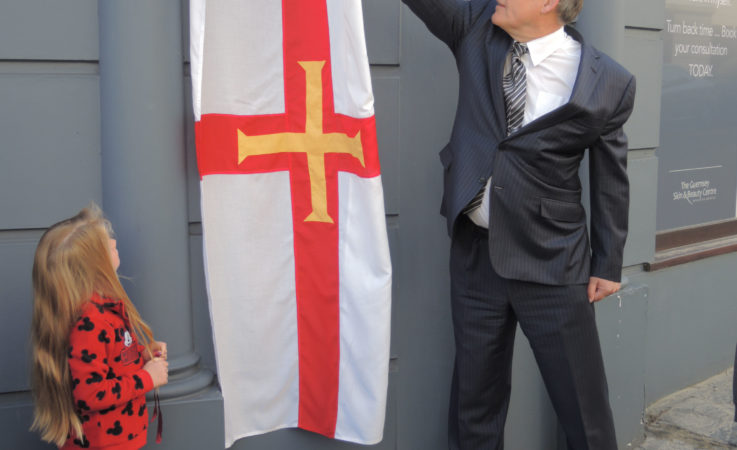
Bailiff unveils GUNS memorial plaque in Guernsey. Copyright Gilly Carr
Deportee memorial Guernsey
The Deportees Memorial was erected in 2010 and unveiled by Sir Geoffrey Rowland, who was Bailiff at the time. It was erected at the instigation of the Guernsey Deportees Association, chaired by Tom Remfrey, and remembers those who died in the civilian internment camps of Compiègne (near Paris), Laufen (on the German-Austrian border) and Biberach (in southern Germany). On 23 April each year, in memory of the day of their liberation from their camps, former deportees gather and lay flowers in memory of those who died and did not come home.
The memorial text reads: ‘This plaque commemorates the illegal deportation by German occupying forces of 1003 men, women and children from Guernsey and Sark in September 1942 and February 1943 to captivity in civilian internment camps in Germany and France’. Underneath the names of 16 people are listed, who range in age from 4 months to 68 years old. Underneath these names is the following text: ‘Also remembering other islanders who were for other reasons deported and died in labour camps and prisons in Europe.’ This memorial was the first and only recognition of resisters (by implication but not name) until the Resistance Memorial was unveiled in 2015.

Deportee memorial Guernsey. Copyright Gilly Carr

Guernsey deportee memorial after guilding of lettering, copyright Gilly Carr

Guernsey deportee memorial on day on unveiling copyright Gilly Carr

Unveiling of Guernsey deportee memorial copyright Gilly Carr
Guernsey foreign worker memorial
In 1999, a memorial was erected in memory of the foreign workers who lost their lives in Guernsey during the German occupation. This first memorial was controversial because, while it listed all those who died, it also included the names of some of the German overseers. Some believed that these men were not worthy of remembrance. Others felt it was inappropriate that victims and persecutors should share the same plaque. Eventually the plaque was taken down and a new one erected in 2001. This one was much simpler; the memorial text reads ‘In memory of all foreign civilians who lost their lives in Guernsey while working as forced labour under the German occupying forces, 1940-1945’.
Every year, on Remembrance Sunday, wreaths of poppies are laid at the foot of the plaque. Groups who tend to lay wreaths at the base of this plaque include the Channel Islands Occupation Society, Festung Guernsey, and Guernsey Armouries. These are amateur enthusiast societies who have taken ownership of and restore many of the German fortifications in Guernsey.

Guernsey foreign worker memorial, copyright Gilly Carr

Guernsey foreign worker memorial, close up, copyright Gilly Carr
1986 memorial to those deported from Jersey
The commemorative stone to civilian internees (or ‘deportees’, as they are called in Guernsey), instigated by Michael Ginns of the Jersey ex-internee association who had been deported to Wurzach in 1942, was first put up in 1985. It is attached to the building in St Helier from which islanders were deported, and is unfortunately small and easily missed. It is around the corner from the Liberation Monument.
A second memorial plaque, dedicated in 1986 to all those deported from the island between 1940 and 1945 (by implication, Jews, deportees and political prisoners, although none of these groups are named), was erected in Howard Davis Park, on the edge of St Helier, and just outside the Allied War Cemetery. The failure of this second memorial to name the separate victim groups and the different reasons why they were deported from the island was the reason why separate memorials to Jews and political prisoners were erected later. The memorial text reads: ‘Jersey Ex-Internees Association. From the rear of this building, 1186 English born residents were deported to Germany in September 1942. In February 1943 a further 89 were deported from another location in St Helier.’

1986 memorial to those deported from Jersey, copyright Gilly Carr

Close up of Jersey ex-internees memorial, copyright Gilly Carr

Michael Ginns standing in front of the Jersey ex-internees memorial, copyright Gilly Carr
Jewish memorial on HMD 2016 in Guernsey
Guernsey’s Jewish Memorial was unveiled in 2001, in time for the first Holocaust Memorial Day, which is commemorated on 27 January each year in memory of the liberation of Auschwitz concentration camp. The memorial is dedicated to the memory of three Jewish women who came to Guernsey in the 1930s, seeking refuge from the persecution they faced in their home countries. They were Marianne Grunfeld (born in Katowice in 1912), Auguste Spitz (born in Vienna in 1901) and Therese Steiner (born in Vienna in 1916). The three women died in Auschwitz.
Each year on Holocaust Memorial Day, a small crowd congregates in front of the memorial for a five minute ceremony in their memory and a wreath is laid. The small memorial plaque has been vandalised twice.

Jewish memorial on HMD 2016 in Guernsey, copyright Gilly Carr

Close up of Jewish memorial in Guernsey, copyright Gilly Carr
Jewish plaque on Westmount memorial in Jersey
In Jersey, a commemorative plaque to the Jews of the Channel Islands was erected in the island’s synagogue in 1998, ‘Dedicated to the memory of those Jews who suffered during the German occupation of the Channel Islands 1940-1945’. This was unveiled on the occasion of an important memorial service at Jersey’s synagogue, held in memory of the Jews who suffered during the occupation. The service was organised by Frederick Cohen, who at the time was president of the Jersey Jewish Congregation, and is also the author of The Jews in the Channel Islands during the German Occupation, 1940-1945.
The speakers at the service included Sir Philip Bailhache (at that time, Bailiff of Jersey); Sir Graham Dorey (then Bailiff of Guernsey); Jon Kay-Mouat, President of Alderney; and Lord Jakobovits, Emeritus Chief Rabbi, among others. Bailhache’s involvement was considered to have been pivotal for the island as his address was the first occasion on which the suffering of the Jews in the Channel Islands had been officially commemorated. Occupation Memorial link.
While there were only c.150 people at the synagogue service, the event was heavily reported in the Jersey Evening Post and so the service became a pivotal one in educating local people about the plight of the Channel Islands’ Jews during the occupation.
On 20 July 1999 the Jersey Jewish Congregation held a service in memory of Therese Steiner, Auguste Spitz and Marianne Grunfeld at the new Jewish cemetery in Jersey. After the service a plaque was dedicated. It reads: ‘To the memory of Marianne Grunfeld, born Katowice 1912; Auguste Spitz, born Vienna 1901; Therese Steiner, born Vienna 1916; Jewish residents of Guernsey during the German occupation. Deported on 21 April 1942 to their deaths at Auschwitz-Birkenau’
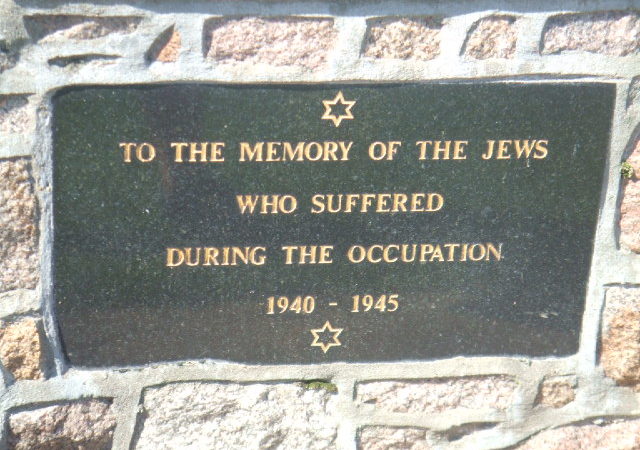
Jewish plaque on Westmount memorial in Jersey, copyright Gilly Carr
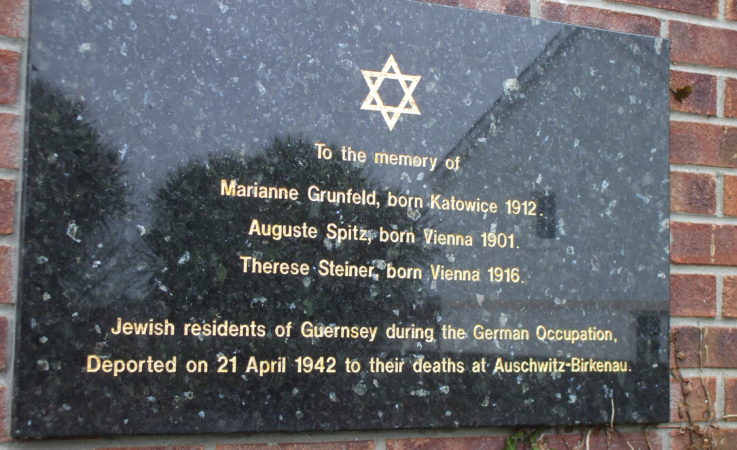
Jersey Jewish Cemetery, copyright Gilly Carr
Lighthouse Memorial Jersey
In 1996 a memorial sculpture was erected in St Helier in the form of a small, reused lighthouse, and dedicated to those known at that time as the ‘Jersey 22’ who did not return from continental concentration camps and penal prisons. At the time of its unveiling, the memorial commemorated only 20 people. The names of Edward Peter Muels and John Soyer were added to the memorial and unveiled on Holocaust Memorial Day in 2003 after their stories came to light.
The Lighthouse Memorial is the focus for the annual Holocaust Memorial Day ceremony, which is extremely well attended by wreath-bearing islanders and dignitaries alike. The memorial is positioned in the harbour, just outside the Maritime Museum which holds the Occupation Tapestry, which features some of the narratives of these people alongside the story of the occupation.
In 2013, it emerged that Walter Dauny, one of the Jersey 22, had survived the war. It was previously thought that he’d been taken from Villeneuve St Georges prison, just outside Paris, and died in a concentration camp, although no records had ever been found to establish his fate. Although he had survived, he was ‘terribly afflicted’, according to a family member, for the rest of his life as a result of his experiences. He lived until 1988. Link to BBC article.
Today, the Lighthouse Memorial commemorates the following people: Canon Clifford Cohu, Arthur Dimmery, Louisa Gould, Maurice Gould, George Fox, James Houillebecq, Frank Le Vilio, Peter Johnson, William Marsh, Edward Muels, John Whitley Nicolle, Leonce Ogier, Frederick Page, Clarence Painter, Peter Painter, Emile Paisnel, Clifford Queree, Marcel Rossi, June Sinclair, John Soyer, Joseph Tierney.

Lighthouse Memorial Jersey, copyright Gilly Carr.

Lighthouse Memorial Jersey. Copyright Gilly Carr.

Lighthouse Memorial Jersey. Copyright Gilly Carr.
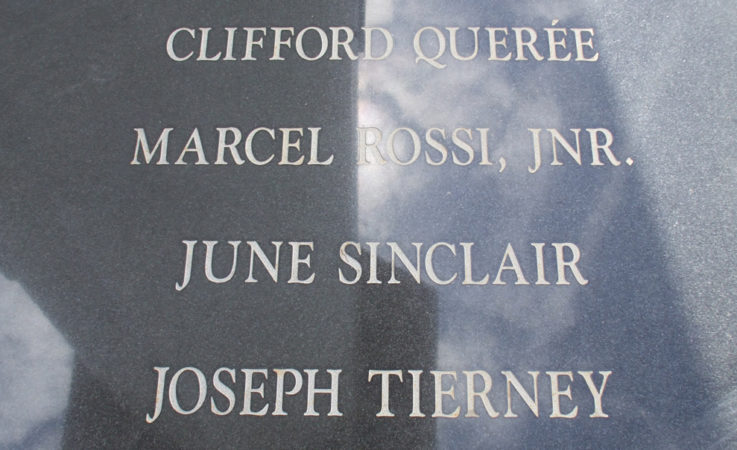
Lighthouse Memorial Jersey. Copyright Gilly Carr.
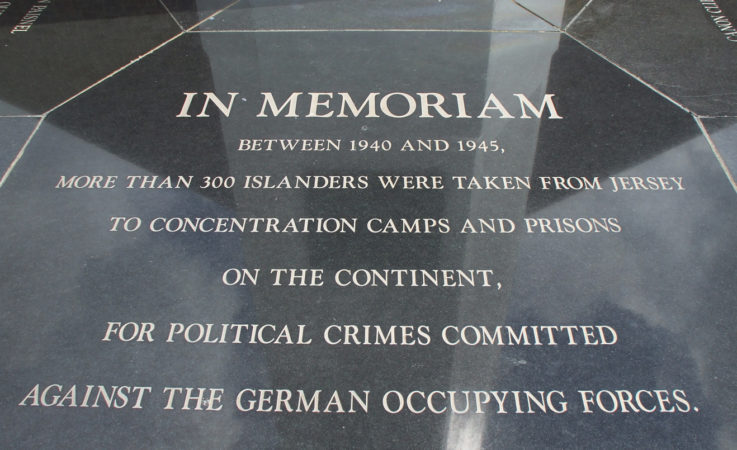
Lighthouse Memorial Jersey. Copyright Gilly Carr.

Lighthouse Memorial Jersey. Copyright Gilly Carr.

Lighthouse Memorial Jersey. Copyright Gilly Carr.

Lighthouse Memorial Jersey. Copyright Gilly Carr.

Lighthouse Memorial Jersey. Copyright Gilly Carr.
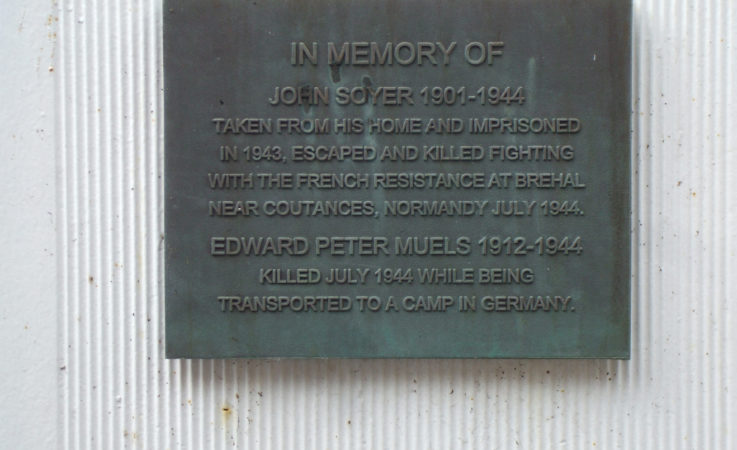
Lighthouse Memorial Jersey. Copyright Gilly Carr.
Marie Ozanne’s Blue Plaque in Guernsey
In 2013, a Blue Plaque was unveiled on the former home of Major Marie Ozanne of the Salvation Army, whose story can be read on this website. She lived from 1906-1943 and was let out of prison to be taken to hospital, where she died of septicaemia following a burst appendix. Marie had a very strong Christian faith and was prepared to die for what she believed in. She is best known for writing letters of protest to the occupying authorities for the way in which they were treating the Jews and the foreign workers in the island.
The Blue Plaque was proposed by William Ozanne, Marie’s nephew, and was unveiled by the Bailiff, Richard Collas, on the 70th anniversary of Marie’s death. The Ozanne family were present, as well as members of the public and of the Salvation Army, who also provided a brass band for the open air service. Speeches were made on the day by the Salvation Army, by William Ozanne, by the Bailiff and by Dr Louise Willmot (Manchester Metropolitan University).
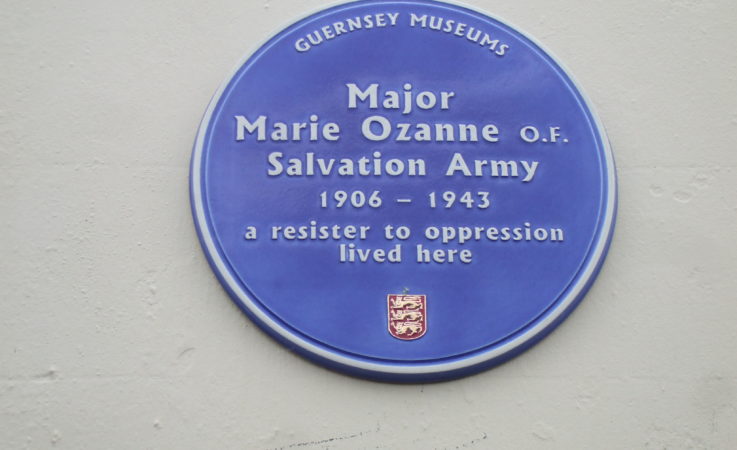
Marie Ozanne's Blue Plaque in Guernsey, copyright Gilly Carr.

Marie Ozanne's grave
Maurice Gould’s grave, Jersey
Maurice Gould, Peter Hassall and Dennis Audrain attempted to escape from Jersey in a dinghy in May 1942. The dinghy capsized, Dennis drowned, and Peter and Maurice swam back to shore, were arrested, and then deported. Maurice died in Wittlich prison in Germany in May 1943. Peter Hassall promised him that he would make sure that his body was brought back to Jersey one day. He succeeded in 1997 and the event was reported in the national news.
In a foreword to his memoirs, written in 1997, Peter Hassall wrote the following:
Over a fifty- year period, I attempted to have Maurice’s remains returned to Jersey, but never succeeded. Perhaps I failed because I was stationed all over the world, and my current home of choice is many thousands of miles away from Jersey, Wittlich and the United Kingdom. However, recent actions by the States of Jersey and the Jersey Branch of the British Legion, finally returned Maurice’s remains to the Island, where he had been recognized as a hero worthy of repatriation. In January, 1997, the States of Jersey, voted in sufficient funds to cover the expenses of the Maurice’s re-interment from Germany to Jersey, and on Monday, 17 March, 1997, his remains were removed from the German Military cemetery, and were re-buried on 3 May, 1997, alongside other British fallen heroes in the War Cemetery, Howard Davis Park, Jersey. It was not a sad event for me, as I had at my side my two dear Breton friends, Guy Faisant and Michel Goltais and their wives. In addition Madame Jacqueline Leitman, the Vice President of our NN organization, was also there to represent the surviving NN – my long half-century Crusade is over – Maurice is home!
Maurice Gould’s grave now features on Jersey Heritage’s Resistance Trail: and another escapee, Michael Neil, narrates the story.

Maurice Gould's grave, copyright Gilly Carr

Close up of Maurice Gould's grave, copyright Gilly C arr
Memorial to Louisa Gould, Jersey
In 1995, as part of the 50th anniversary of the Liberation of Jersey, a number of memorials and memorial plaques were erected. One was to Louisa Gould. A plaque was erected on her house in her memory. Louisa is well known throughout the Channel Islands today for having sheltered a Russian slave worker. She was eventually informed upon, arrested, and deported. She died at Ravensbruck.
The memorial text reads: ‘In this house Mrs Louisa Mary Gould, née Le Druillenec, sheltered an escaped Russian P.O.W. during the German occupation from October 1942 until May 1944. After her arrest she was deported to the concentration camp at Ravensbruck where she perished in the gas chamber.’
The same year, Louisa Gould’s name was added to the war memorial in the parish of St Ouen.

Louisa Gould's plaque close up copyright Gilly Carr

Louisa Gould's house, copyright Gilly Carr

St Ouen War Memorial, Jersey, copyright Gilly Carr

Close up of St Ouen war memorial, copyright Gilly Carr
Pavement Slabs Memorial in Jersey
In 2005, to mark the 60th anniversary of Liberation, pavement slabs were installed in the Charing Cross area of St Helier. They are engraved with quotations from members of the occupation generation and many are from victims of Nazism. Each of the quotes is moving and gives an insight into traumatic experiences and suffering.

Pavement Quotes Memorial in Jersey, copyright Gilly Carr
‘Forgiveness leads to understanding. Understanding leads to friendship. Friendship leads to reconciliation. Reconciliation leads to peace, Both in our hearts and in the world.’ (Michael Ginns MBE, Islander and Occupation veteran who has led reconciliation initiatives)
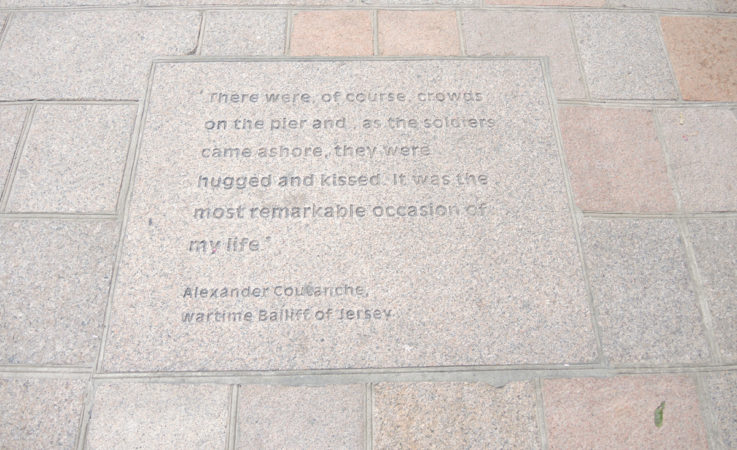
Pavement Quotes Memorial in Jersey, copyright Gilly Carr
'There was of course crowds on the pier, as the soldiers came ashore, they were hugged and kissed. It was the most remarkable occasion of my life.' (Alexander Coutanche, Wartime Bailiff of Jersey)

Pavement Quotes Memorial in Jersey, copyright Gilly Carr
‘I was called number 146. No one ever used my name.’ (Alexei Ikonnikov, Russian slave worker)
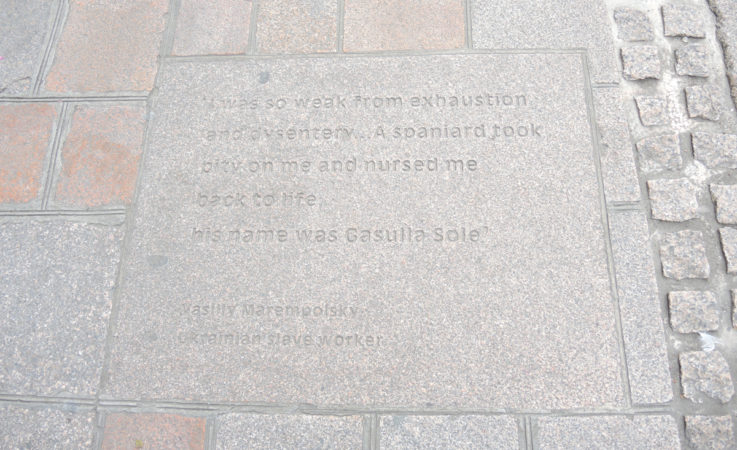
Pavement Quotes Memorial in Jersey, copyright Gilly Carr
‘All we could think of was that every day we were alive was a bonus’ (Vincente Gasulla Sole, Spanish forced labourer)

Pavement Quotes Memorial in Jersey, copyright Gilly Carr
‘I was so weak from exhaustion and dysentery. A Spaniard took pity on me and nursed me back to life. His name was Gasulla Sole.’ (Vasilly Marempolsky, Ukrainian slave worker)

Pavement Quotes Memorial in Jersey, copyright Gilly Carr
‘Nazi racists ranked their Russian slave workers as sub-human. Any racial prejudices we personally may harbour are first steps on that same viciously slippery slope.’ (Bob Le Sueur, Islander and Occupation veteran, recognised by Russia for assisting slave workers)

Pavement Quotes Memorial in Jersey, copyright Gilly Carr
'I thought that if I was going to be killed, I would rather be killed for a sheep than a lamb'. (Albert Bedane, Islander recognised by Israel as Righteous Among Nations for saving the life of a Jewish woman).
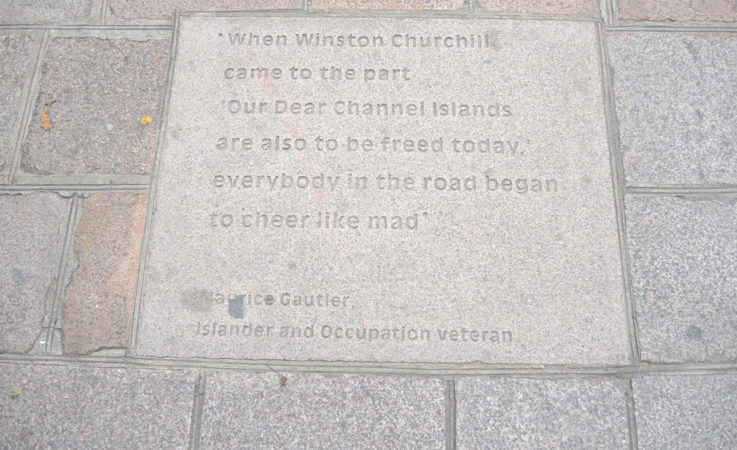
Pavement Quotes Memorial in Jersey, copyright Gilly Carr
'When Winston Churchill cam to the part "Our dear Channel Islands are also to be freed today" everybody in the road began to cheer like mad'. (Maurice Gautier, Islander and Occupation Veteran).

Pavement Quotes Memorial in Jersey, copyright Gilly Carr
‘I shall never forget the kindness shown to me and the other slave workers by the people of Jersey’ (John Dalmau, Spanish forced labourer).

Pavement Quotes Memorial in Jersey, copyright Gilly Carr
'There was no discussion about whether to help the escaped labourers or not. They just couldn't help themselves.' (Stella Perkins, Islander and Occupation Veteran. Recognised by Russia for assisting slave workers).

Pavement Quotes Memorial in Jersey, copyright Gilly Carr
‘I have to do something for another woman’s son.’ (Louisa Gould, Islander who perished in Ravensbruck having been denounced for hiding an escaped slave worker)
Political prisoner memorial in St Helier Jersey
Former political prisoner, Joe Mière, was the instigator of the first memorial to political prisoners in Jersey. It was erected in 1995 after much struggle with the authorities. It was important to Mière to place it in Gloucester Street, on the site of Jersey’s occupation prison, now-demolished. In his private correspondence he reveals that when the local government at last acceded to his request to erect a memorial, they initially wanted to place it in a less visible location.
Despite Mière’s complaints, the local authorities also decided to give the official unveiling of the memorial little advance publicity, because of the ‘perceived sensitivities’ surrounding the belief that ‘many of the offences [committed] would have been punishable under normal civilian law and indeed could have been described as criminal.’ [Jersey Archives reference C/C/L/C9/1.]
Although Mière got his wish, with the memorial unveiled by the new Bailiff, Sir Philip Bailhache, the memorial is unfortunately currently neglected, although there are plans for the lettering to be repainted. The memorial plays no part in annual commemorative ceremonies and although the lettering was, until recently, peeling and partially obscured by ivy, making it difficult to read, it has recently been re-gilded. The memorial text says:
During the period of the German occupation of Jersey from 1st July 1940 to 9th May 1945, many inhabitants were imprisoned for acts of protest and defiance against the Occupation Forces in H.M. Prison, Gloucester Street, which stood on this site. Others were deported and held in camps in Germany and elsewhere from which some did not return. This Plaque is placed in their memory with grateful thanks from the people of Jersey on the 50th anniversary of the Liberation of Jersey, 9the May 1995. This Plaque was unveiled by Mr Philip Bailhache, Bailiff of Jersey, on 27th April 1995.
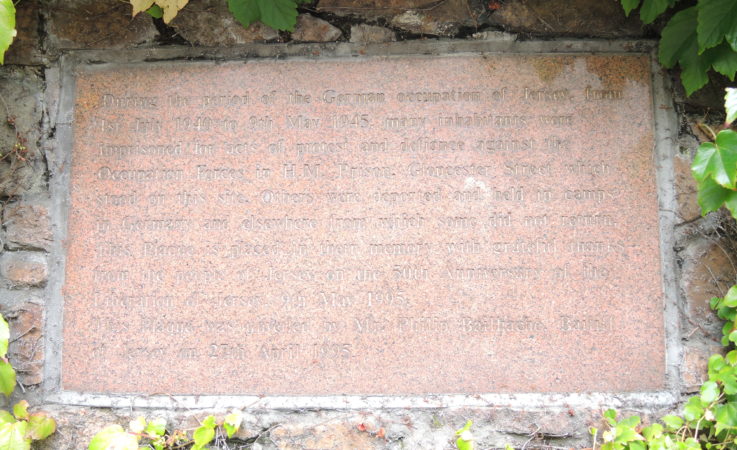
Political prisoner memorial in St Helier Jersey, copyright Gilly Carr
Resistance Memorial in Guernsey
The Resistance Memorial in Guernsey was unveiled by the Bailiff of Guernsey, Richard Collas, on 4 May 2015 and in the presence of many resistance families, including representatives of families of the ‘Guernsey 8’.
The Guernsey 8 were the eight islanders who died in German and Nazi-controlled prisons, labour camps and concentration camps during the German occupation. The memorial reads ‘This memorial is dedicated to the memory of all islanders who committed acts of protest, defiance and resistance during the German Occupation 1940-1945, those who were imprisoned or deported and those who died in captivity’. The names of seven of the Guernsey 8 are Charles Machon, Percy Miller, Marie Ozanne, Joseph Gillingham, Sidney Ashcroft, Louis Symes and John Ingrouille.
The memorial was erected at the instigation of the family of Joseph Gillingham, although many others also donated money towards it. During the service of dedication which accompanied the unveiling, flowers were laid and speeches were made by the Bailiff and by Dr Gilly Carr (University of Cambridge). The Bailiff hosted the family members of the Guernsey 8 in his chambers afterwards for a Vin d’Honneur.
On Holocaust Memorial Day 2016, the memorial was incorporated into the outdoor service and flowers were laid by Angela McAllister, daughter of Frank Tuck who was sent to Neuoffingen camp during the occupation.

Resistance Memorial in Guernsey, copyright Gilly Carr

Resistance Memorial in Guernsey, copyright Gilly Carr

Resistance Memorial in Guernsey, copyright Gilly Carr

Resistance Memorial in Guernsey, copyright Gilly Carr

Resistance Memorial in Guernsey, copyright Gilly Carr
The Occupation Tapestry, Jersey
The Occupation Tapestry was made as part of the 50th anniversary of Liberation celebrations in 1995. It was unveiled by Prince Charles. There are twelve tapestry panels and each was made by a different parish in Jersey. There were several inspirations for this tapestry including (ultimately) the Bayeux Tapestry, but more recently, the Overlord Embroidery, which is on display in the D-Day Museum in Portsmouth.
The Occupation Tapestry project began in 1988, and the designer was Wayne Audrain of Jersey Museums Service. Doug Ford, who also worked for Jersey Museums Service, drew up a list of twelve subject areas broken down into a number of possible scenes, from which Wayne selected the most visually appealing.
The content of the panels was based on black and white photos. The stitching took place from February 1991 till November 1993 and was completed by volunteers from each parish. The themes of the panels are as follows:
Outbreak of War
Occupation
Restrictions
Transport
Everyday Needs
School and Work
Social Life
Government
Sent Overseas
By-passed
Red Cross
Liberation
The Occupation Tapestry Gallery was freshened up in 2015. Touch-screens were added beneath each panel to tell stories omitted or marginalised; stories untold because of their difficult nature; and information on the wider European context. A new film was made to feature in the gallery. It shows members of the community and those involved in occupation memory, talking about how the memory of occupation has changed over the decades since 1945. Images showing how Liberation Day celebrations have changed over the decades are now projected above the tapestry panels.
To commemorate the 70th anniversary of Liberation, a new, 13th, panel was commissioned. The concept behind the design was produced by Dr Gilly Carr, who wanted there to be a strong representation both of victims of Nazism, and those who had become their guardians of memory since the occupation. The tapestry design thus features a number of memorials, showing the way that the occupation years have been remembered in Jersey. The new panel was completed in 2016. Wayne Audrain once again designed the final image.
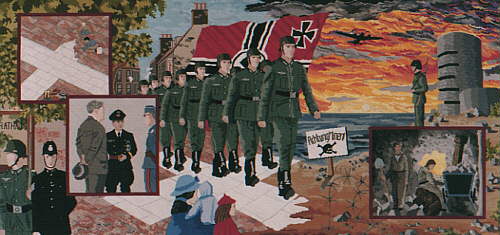
The Occupation Tapestry, copyright Jersey Heritage

The Occupation Tapestry, copyright Jersey Heritage

The Occupation Tapestry, copyright Jersey Heritage

The Occupation Tapestry, copyright Jersey Heritage

The Occupation Tapestry, copyright Jersey Heritage

The Occupation Tapestry, copyright Jersey Heritage

The Occupation Tapestry, copyright Jersey Heritage
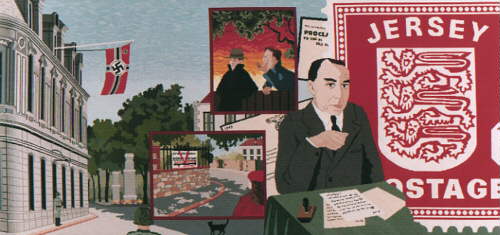
The Occupation Tapestry, copyright Jersey Heritage

The Occupation Tapestry, copyright Jersey Heritage

The Occupation Tapestry, copyright Jersey Heritage

The Occupation Tapestry, copyright Jersey Heritage

The Occupation Tapestry, copyright Jersey Heritage

The Occupation Tapestry, copyright Jersey Heritage
Westmount Memorial Jersey
A Soviet timber ship, the mv Jarensk, visited Jersey in 1960. Its crew members were taken by local members of the Communist Party (notably Norman Le Brocq) to the Strangers’ Cemetery at Westmount, St Helier, to see where their dead comrades had been buried during the German occupation. As Norman Le Brocq and his friends had been involved in helping escaped OT workers, a friendship still existed between the Jersey Communist Party and the OT workers (who mostly comprised the Spanish Republicans) who stayed in the island after the war.
Seeing that no proper memorial marked the spot, the visiting Russians were spurred to make a collection for a commemorative plaque. Although it was installed in the cemetery, it was moved when the German war graves commission, the Volksbund Deutsche Kriegsgräberfürsorge, visited the island the following year to remove their own war dead along with the OT workers.
On the 25th anniversary of liberation, in 1970, the plaque (now with a concrete base) was placed in the island’s crematorium. It, along with a portable plaque commemorating Spanish Republicans, was used once a year on Liberation Day. Francisco Font, a prominent Spanish Republican and former forced worker who had stayed in the island, kept the plaque in his home. On 9 May each year, he and his friends would put the two plaques in a wheel barrow to carry them to a patch of ground in the middle of the crematorium, put them on the ground, and place flowers on them. On Liberation Day, members of the Jersey Communist Party and the Spanish Republicans would gather to remember those who died. Although the Communist Party members used the occasion to give political speeches (something which deterred most islanders from attending), for the Spaniards it was a time to recall their struggle during the Spanish Civil War.
After some difficulty, and a tussle over the wording, Font, along with some members of the Jersey Communist Party (Norman Le Brocq, Stella Perkins and Henny Prax), was given permission in 1971 to erect a granite horseshoe-shaped memorial in the crematorium grounds. The desire for a permanent memorial was most likely triggered by the original plaque paid for by the crew of the Jarensk. The new memorial was installed with the Jarensk plaque, that of the Spanish Republican community, and one from the French Consulate.
A new Russian plaque was later provided in 1978 by the Russian Naval attaché from the London Embassy. In subsequent years, plaques to the Polish, Jewish, Belgian, French North Africans, and Belarus labourers have been added.
Today, the Westmount Memorial is the focus of an afternoon ceremony on Liberation Day in Jersey. The event is led by Francisco Font’s son, Gary Font, and people gather to remember the 101 forced and slave labourers who died building the Atlantic Wall in Jersey. The event today is no longer an occasion for political speeches, although speeches are given in memory of those who died. The Bailiff and Lieutenant Governor, as well as other islanders representing various groups and individuals, attend and lay flowers.

Westmount Memorial Jersey, copyright Gilly Carr